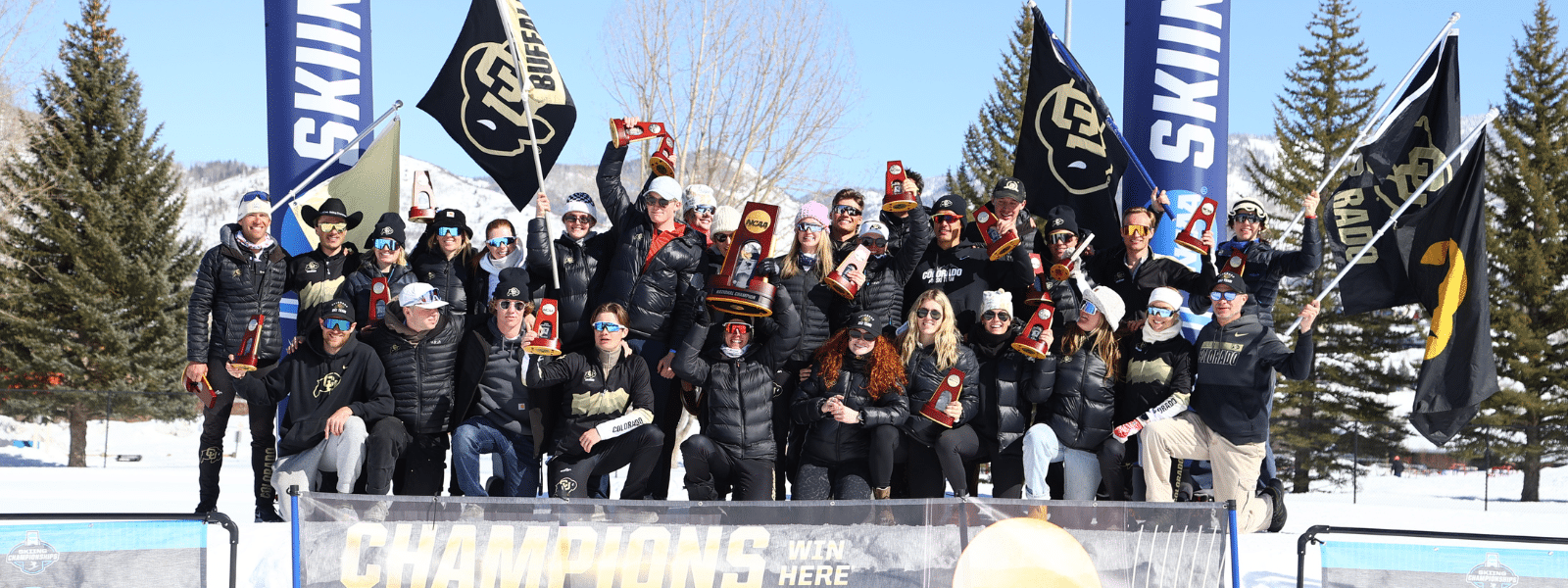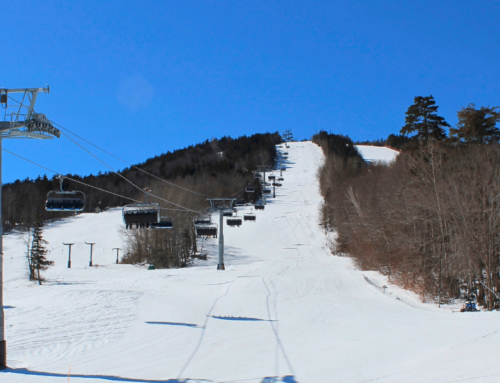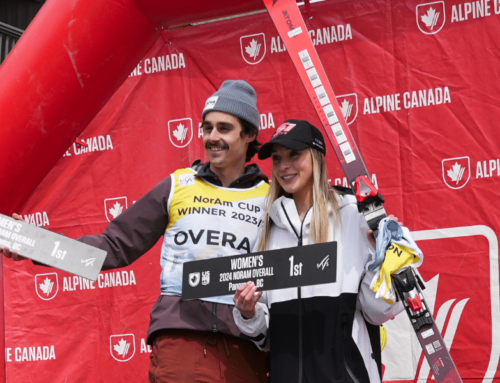Hans Standteiner: The Heart of the Mountains
Father’s Day is a great day to honor all ski dads, but this Father’s Day, one was especially missed. Squaw Valley’s “Opa,” Hans Standteiner Sr, passed away May 29. He left behind five children and ten grandchildren as well as countless skiers across the country and around the world who learned to love the sport through his sparkling blue eyes, bright smile and easy laughter.
Hans was born on March 13, 1930, in Austria’s Gastein Valley, known for its beautiful mountains, its skiing and its healing caves. In the post war privation, his parents sent him to live with relatives on a nearby farm, where food was more plentiful. As young Austrians in the mountains do, he also grew up ski racing, becoming one of Austria’s best. Erich Sailer, who fondly remembers first meeting him at a ski race in Lech, notes that, “none of us just ski raced. We also learned a trade.” Hans’s was blacksmithing, which was both industry and art. He spent his summers doing the hard, mountain work. While helping build a hydroelectric dam near the Kitzteinhorn, he had an accident and lost two fingers. Coworkers strapped him to the materials tram to get off the mountain, and Hans then waited for a bus in the town of Kaprun, arriving at the hospital hours later. The doctor fashioned one of his remaining fingers into a hook, so he could better handle the tools of his trade. Those included a hammer and a ski pole.
Standteiner completed his three year ski instructor training and then, like so many other Austrians at the time, set off to share his craft. Those travels took him to Iran (he skied with the Shah and his family), and to Turkey, where might have stayed had a friend—Hans Friessnig —not convinced him to come to Sugarbush in Vermont. There, while teaching a group of young women from New York how to be instructors, he met Alice Gray, a glamorous model and adventurous soul who had fallen in love with Austria on a trip to Europe. Now, she fell in love with an Austrian. When her banker father told Hans of Alice’s many Wall Street suitors, Hans assured him, “Well, there’s a lot of rich good looking women after me too!”
Alice and Hans married and honeymooned in Bariloche, Argentina, where he coached the future Argentinian Olympic team, and picked up the job of coaching the Chilean Olympic team at the 1960 Olympics in Squaw Valley. In the meantime, he had been hired by Don Schwartz at Iroquois Mountain in Michigan to coach their racing team. He and Alice moved to Sault St. Marie, where Hansi and Barbara were born. Mike Porcarelli, future national and NCAA champion, remembers Hans shooing the younger kids away from the course. “Go ski!” he’d admonish them. From there, Hans moved to Indian Head, MI, to run the Ski School, and still coach as much as possible. The racers followed. Central Division kids, led by Greg Schwartz and Porcarelli started making their mark nationally, while Hans brought the Austrian lifestyle to Michigan, hiring instructors who were also musicians. Summers, he worked on the lifts while Alice and the kids—three now, with Erika— went to Austria. Sailer, who had also landed in the Midwest, and recruited Hans to coach at his ski camps in Wisconsin, remembers that Hans, “knew what he wanted and he knew who he was.”
He was, at heart, a mountain person, and when Schwartz moved to Sugar Bowl in 1968, Hans eagerly accepted his invitation to run the race team. There he met fellow Austrian Ernst Hager, who was spending a year in the ski school. That first winter was a monster snow year, and the Standteiner family had to tunnel out of their home in Soda Springs. When Hans went to Squaw Valley the next summer to watch the annual Soap Box Derby, he saw a year-round community with families and playmates for the kids. The family moved there in 1969, and that same summer Hans opened the “Mountain Forge” along the river between Truckee and Tahoe City.
In 1970 he took over the Squaw Valley Ski School, along with Stan Tomlinson. As he had done in Michigan, Hans made sure to hire Austrian instructors who were also musicians, adept at traditional Austrian folk music. Thursdays became “Tyrolean Night” at Squaw’s Bar 1, featuring yodeling, lederhosen-clad instructors and lively “Schuplatteln” dancing. While playing tennis one day, as he often did, Hans saw Ernst Hager, who was vacationing from Austria with his wife Linda. “Perfect!” said Hans. “We need a coach!” Ernst — who went on to coach the U.S. Ski Team from 1975-85, and 1991-96 — took over the Squaw Valley Ski Club race team while Hans ran the Ski School, and Alice and Linda ran daycare out of the “Gingerbread House.” By then, with the addition of Toni then Heidi, there were five Standteiner children, who all grew up to be talented and enthusiastic ski racers.

Austrian-born, Standteiner, left his mark on the ski culture in America with his pure passion of the sport.
Hager was in charge of the race team, but Hans was always nearby, setting his trademark tough courses, with interesting combos, sharp corners and various challenges that “tricked you into skiing better,” recalls Hansi. Hager shared Hans’s philosophy of keeping skiing fun. “We believed in being personable with the kids, and motivated them by being funny and keeping it light. Kids loved Hans.” He was unstructured, yet uncompromising on mastering the basics of the classic Austrian stance—arms out, body quiet—and edging with the knees and ankles. In those pre-Internet days, the racing community gathered around Hans for updates on the latest World Cup results from his short-wave radio. His friendliness and humor defused the often fiery mix of personalities and nationalities that presided over Squaw’s four separate race teams. Hans charmed them all, and this potentially contentious environment instead assimilated the Standteiner spirit, becoming an energetic, dynamic and fun-loving culture that leveraged and fostered talent. What emerged were kids adept at skiing the whole mountain and the toughest courses in all conditions, and who above all loved the sport.
Either directly through his coaching, or indirectly through the ecosystem he fostered, Hans shepherded three of his own kids—Hansi, Toni and Heidi—on to the National Team, as well as many, many more from that era (and well beyond). Among them was his uphill neighbor Tamara McKinney, with whom Hans had deep technical conversations about both skiing and tennis. Hans accompanied Tamara to many big ski events, during and after her competitive career, always managing to end up in the VIP area surrounded by old and new friends. As Tamara recalls “He loved Austria, but really anywhere we were, everything was ‘FanTAHstic!’” This contagious enthusiasm came from his unwavering support for pursuing one’s passions. When Erika quit ski racing to become a cheerleader, Hans and Alice took the front row in the bleachers to watch her shine, and when Barbara shifted her focus from ski racing to college, “he told me he’d never been prouder of me,” Barb recalls.
As Hansi grew up, and while he was becoming one of the top U.S. slalom skiers, the two worked together all summer at the forge. Hansi learned the craft and Hans was a one-man sales force, talking up customers and building his reputation for creating fine work and lasting friendships. “He was such a PR guy,” recalls Hansi. “He built the business on his personality.” The Standteiner’s chalet—presided over by Alice’s casual, open-door, open-hearted style—was home to scores of “orphans” who thrived in the sociable, free-range atmosphere. Hans made any venue into his own Stammtisch, with people gathering for a coffee or a glass of white wine, and always conversation and laughter. “Everywhere was his hangout,” notes Hager.
In the Eighties, Hans moved out of the ski school and into a “Director of Skiing” role at Squaw. The Mountain Forge continued to grow, and when it moved to a state of the art facility in Truckee 12 years ago, Hansi and Toni had taken charge, furthering the old world tradition of designing and hand-crafting functional art. Their work ranges from large installations like railings, outdoor sculptures, staircases and gates, to smaller ornamental work like fireplace tools, chandeliers and cabinet hardware. Of course, ski racing is also part of the mix. Mountain Forge crafted the medals awarded for the Squaw Valley World Cup, and the “Coach’s Heart” awards for this year’s graduating class at Sugar Bowl Academy.
When Alice passed away from cancer in 2007, it left an unfillable void not only in the family but in the entire community. Family, and the ski world, encircled Hans even more tightly.
All five Standteiner kids continue to ski, and all ten grandkids were or are in local junior racing programs. As Barbara’s kids excelled at soccer, Hans added that sport to his obsessions. Hans followed all the grandkids, on snow while he could still ski, and then from the finish line and sidelines. Throughout his bout with Parkinson’s Disease, Hans continued to stay current on and engaged in all the latest ski racing scoop. Right up to his last day, he was able to tell Hager that his favorite musical group was Flizmooser Tanzlmusi and had it blaring.
At Squaw Valley, his legacy endures well beyond the trail that bears his name, and is captured by fellow Austrian legend and fan, Hermann Gollner: “Everything he gave us was coming from the heart. That is why kids loved him so much. We all have come across expert scholars of the skiing world and all their knowledge became eventually outdated and ended up in the waste basket. They have not gotten what was absolutely natural to Hans. A love for the game itself and not a love for one’s own purpose.”
A memorial for Hans is planned for August 17 in Squaw Valley, at 5 pm on the KT Deck.






















